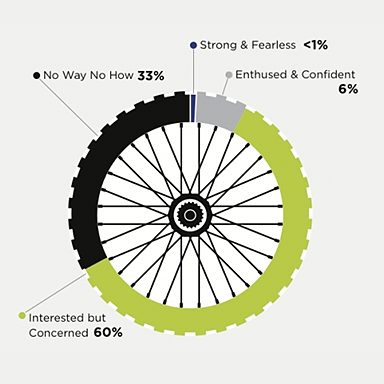
Updating Bicycle Parking in the City
Tyler Kimbrell, Planner II, 509.625.6500
Tuesday, February 7, 2023 at 10:52 a.m.

A virtual open house will be Wednesday, Feb. 15 from 6:30-7:30 p.m. regarding updating the City’s Bicycle Parking Code. The meeting passcode is snGzbJkM239
The Bicycle Parking Code Update seeks to amend the current code (SMC 17C.230.200) to ensure the lasting applicability of the code and to provide more flexibility in the future. Three key elements of the update are:
- differentiating between the short-term and long-term storage of bicycles;
- removing the relationship between vehicle parking requirements and bicycle parking requirements; and
- providing best practice guidance for bicycle rack design and placement.
Why update now?
Both the Comprehensive Plan and the Bicycle Master Plan outline the need for more bicycle parking. Bicycle parking is one of the key infrastructure pieces that incentivize people to ride their bikes as a preferred mode of transportation.
The other key infrastructure pieces are bicycle lanes, shared-use paths, and end-of-trip facilities. The City is continually investing in bicycle lanes as part of the Bicycle Master Plan as construction funding is available. Examples of new bicycle lanes include the protected lanes along Riverside Avenue in downtown and the bicycle lane striping along the Maple and Ash Street corridor.
When it comes to the decision on whether to commute via bicycle there are a few different categories of cyclists:
- The “strong and fearless” (less than 1 percent of the population) are those who will ride their bicycle no matter the speed and volume of the adjacent vehicles.
- The “enthused and confident” (about 6 percent of the population) are those who will ride adjacent to high-speed and volume traffic but appreciate designated bicycle facilities.
- The “interested but concerned” (about 60 percent of the population) is the group that the update to the bicycle parking code is targeting. This group is willing to ride their bike so long as there are safe and accessible bicycle facilities along their route. Adequate bicycle facilities include protected bike lanes, end-of-trip facilities, and bike storage.
- The “no way no how” (about 33% of the population) is the group does not bicycle due to a lack of interest or ability.
As one can see the “interested but concerned” category of ridership contains the largest portion of the population. By tailoring policies, projects, and development codes to the needs of the “interested but concerned” cycling can once again be the mode of choice for commuting in the City of Spokane.
A history of cycling in Spokane
Spokane has a great history of cycling. In the late 19th Century, prior to the automobile becoming commonplace, a network of “cinder paths” were developed that connected neighborhoods to places of employment.
According to a Spokesman-Review article, these paths were being developed fervently as they represented respite from slow or otherwise burdensome transportation methods such as walking or horses. These paths were a necessity for cyclists, in the same way that asphalt roads are a necessity for motor vehicles today, they allowed cyclists to ride free of obstruction from other road users. Unlike today’s roads, these cinder paths only took up 5 to 9 feet of right of way - the rest could be used for other road users and buildings alike.
About 5,745 feet of this path was developed in 1898 costing a total of $1,459.81 (approximately $45,000 to $50,000 in 2022 dollars) and cycling exploded in popularity thereafter. Personal motor vehicles overtook cycling in popularity in the new century as the operative mode of transportation requiring the cinder paths to be repurposed into vehicle roadways.
Despite the falter in cycling popularity following the mass availability of personal motor vehicles, Spokane has always had a subsect of hardcore cyclists. As this Inlander article notes, clubs such as the Spokane Bicycle Club and recreational cyclists, both road and mountain, have kept the sport alive and well despite the lack of cycling infrastructure. Events such as Spokane’s 24 Hours Round the Clock mountain bike race, which ran from 1999 to 2019 and looks to have been replaced by 24 Hours of Riverside, show that cycling in Spokane has a grand following, with more than 800 cyclists attending the race in 2019. Likewise, Summer Parkways will return this year after the event’s biggest year to date in 2022, with an estimated 3,000 people of all ages and abilities bicycling and walking along the low-stress neighborhood route at the summer solstice.
More information
To stay up to date with the project and get more information, visit the Bicycle Parking Code Update page.
More About...
- Bicycle
- Bike
- Bike Lane
- Commute
- E-Bike
- Engage
- Lime
- Live
- Micromobility
- Parking
- shared mobility
- Transportation
- WheelShare

